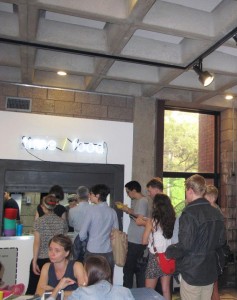Time Banks: Got Time for Lunch?
Last weekend, I was walking around New York’s Lower East Side when I stumbled upon an interesting restaurant. The counter was serving Thai food, but they didn’t take cash – they only took time.
 For a home-cooked lunch (with table service), I was told I’d have to pay with a half-hour of my time. This was an alternative economy staged by artists Julieta Aranda and Anton Vidokle as part of Creative Time’s Living as Form exhibition, part of a larger community movement of time banks going on nationally.
For a home-cooked lunch (with table service), I was told I’d have to pay with a half-hour of my time. This was an alternative economy staged by artists Julieta Aranda and Anton Vidokle as part of Creative Time’s Living as Form exhibition, part of a larger community movement of time banks going on nationally.
A time bank is not a barter system. Your good (or service) is not directly exchanged for another good or service. There’s a medium of exchange: it’s time, not money.
Some interesting history from their artist statement:
The origins of time-based currency can be traced both to the American anarchist Josiah Warren, who ran the Cincinnati Time Store from 1827 until 1830, and to the British industrialist and philanthropist Robert Owen, who founded the utopian “New Harmony” community. While both systems are based on the principles of mutualism and the labor theory of value, Josiah Warren’s currency was explicitly pegged to time as a measure of specific goods or labor.
The first successful contemporary time bank was started in 1991 by Paul Glover in Ithaca, New York. Following his idea, people began to exchange time, which led to the creation of a time-based currency—the “Ithaca Hours,” which even local businesses began to accept, and which still flourishes. Time banking and service exchange have since developed into a full-fledged movement, usually centered around local communities.
I was intrigued but taken aback as I realized that I value my time a lot. I don’t have a good reason to — I don’t have kids or multiple graduate degrees or a special skill that makes my time particularly valuable. I do however have a lot of hobbies and friends, and I love to sleep 8 hours a day.
But since time was being treated as a currency here, I sat down and figured out a quick personal exchange rate. I took my current salary (since I supposedly would have to work to pay the time back) and divided it to approximate how much one minute of my time is worth in the current market economy, and I compared that against how much I value a home-cooked Thai lunch. I also considered the value I place on participating in a public art project, and whether I could pay the time back doing something I enjoy. This is a really rough approximation, but it helped me think about paying with time more clearly.
I think time banks are a good way to get people thinking about value on a personal level, but, for practicality’s sake, the scale of such a currency can only be small and locally-based. Time is finite, whereas money is not, and we all only have 24 hours a day — so what would we do for the things in our world that cost more than the amount of time we have?
Incidentally, there’s a Justin Timberlake sci-fi movie coming out next week about a world where the currency is time. Maybe we have time banks to thank for that. (Or not.)

Comments